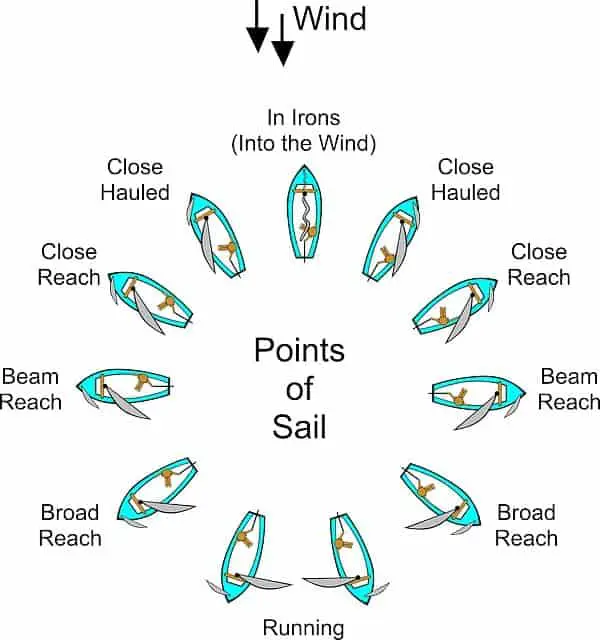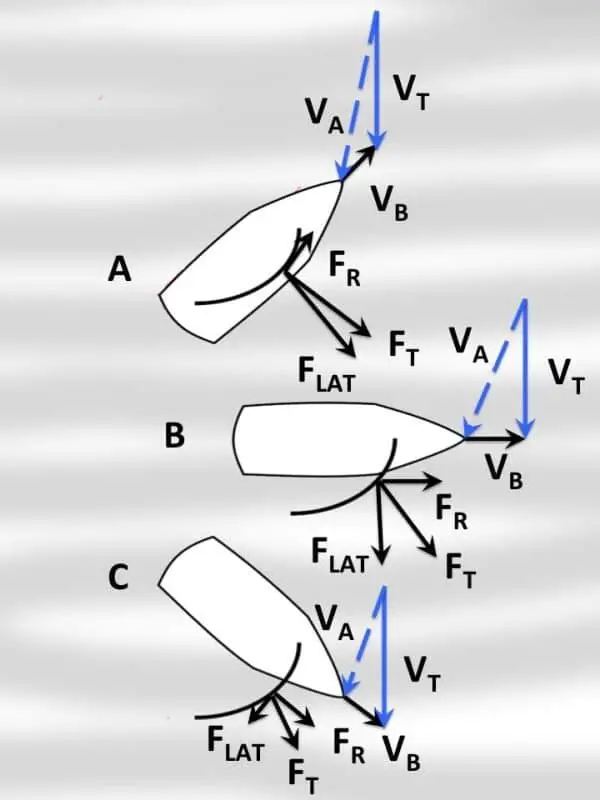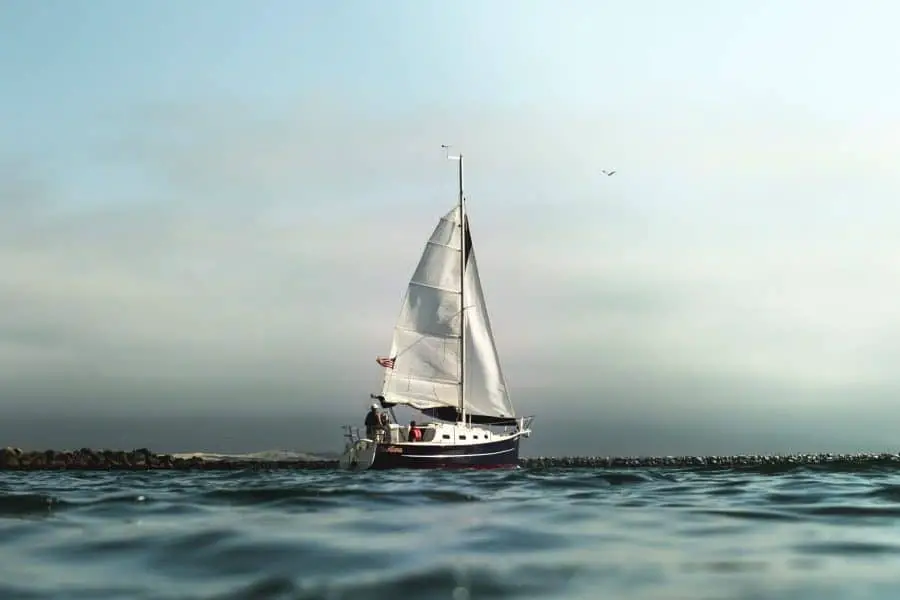Depending on the direction of the wind and where you’d like to take your sailboat, you’ll need to consider which point of sail to be in. Whether you’re sailing upwind (windward) or sailing downwind (leeward), your sails will either take on the characteristics of an airplane wing or a parachute.
So what are the points of sail on a sailboat? The points of sail include into the

Knowing the points of sail on a sailboat is important in terms of being knowledgeable about how your sailboat generates wind power while also being able to properly communicate with your crew.
It’s also important to understand the difference between upwind sailing and downwind sailing.
There’s a lot of sailing terminology to hash out here as well, so let’s dive into all the different points of sail and learn what they all really mean.
Points of Sail
A point of sail is the direction of a sailboat’s journey while taking into consideration the direction of the true wind as opposed to apparent wind.
The difference between true wind and apparent wind is that true wind is the wind that’s felt by something or someone in one place (like on land) while apparent wind is the wind felt when on the move (like on a sailboat).
The points of sail, when combined, complete a full 360 degrees. Starting from the top (0 degrees) all the way to the bottom (180 degrees), we’ll now explore the different points of sails.
1. Into the Wind (In Irons)
Being into the wind or in irons means your sailboat is going straight into the wind (plus or minus 45 degrees from 0), which will prevent your sailboat from… sailing!
Being into the wind can’t be 100% avoided, and it shouldn’t be, but it’s generally not where you want to be if you plan on moving.
The into the wind point of sail is more often a pivot point for when performing other sailing actions including tacking as well as raising and lowering the mast.
When tacking, your point of sail will change from one side of the sailboat to another while crossing the into the wind point of sail. If you’re not able to cross this point of sail fast enough and get stuck, this is called being “taken aback”.
This is also considered the “no-go zone” or “no sail zone” because, you guessed it, you won’t be going anywhere fast when in this space for too long.
If
2. Close Hauled
The close hauled point of sail is a tad bit greater than the 45-degree mark on either side of the sailboat.
When at this point of sail, you’ll sail upwind and is often called “beating” as well as “working windward” since your boat is moving toward the wind. Sailing close hauled means you’ll be feeling the wind much more as a captain and crew member!
While sailing close hauled, your sail will be functioning as similar as it can to a wing on an airplane due to it cutting the wind dead on resulting in generating a lot of life.
As a matter of fact, this is when you’ll have the tightest sail trim. The closer you are to the wind (or the “no-go zone”), the more to “point” your sailboat will be.
3. Close Reach
As your sailboat “bears away” (moves away from the wind), it’ll enter the close reach point of sail. This point of sail sits right in between the close hauled and beam reach points of sail on either the port or starboard side of a sailboat. Close reach is a fun and fast point of sail for many sailors!
Close reach is the closest point of sail to the “no-go zone” as any other point of sail, so it’s important to pay attention to the wind and your boat sails.
Since sail trim is so important when it comes to your sailboats speed, it’s important in a close haul to keep your sail tight (similar to a close hauled point of sail) but loose enough so it’s just on the verge of luffing.
4. Beam Reach
When entering a beam reach point of sail, your sailboat will be perpendicular to the wind either on the starboard or port side.
Being in beam reach means you’ll be letting your sails halfway out and you’ll be moving relatively faster than other points of sail. As a matter of fact, it’s known to be the fastest point of sail when on a sailboat!
Not only is beam reach the fastest point of sail on a sailboat, but it’s also the most comfortable due to having more control.
The way in which the wind hits your sails at this point of sail means your boat will be transferring energy more efficiently from the sideways force of the wind to the propelling motion forward.
5. Broad Reach
Moving away from a beam reach and into a broad reach point of sail results in letting your sails out about 2/3 of the way.
At this point of sail, the wind is not coming astern from your sailboat and your sail will act more like a parachute than a wing. Now that you’re sailboat’s heading downwind, you’ll also feel a little less of a windy feel but still should be chugging right along.
Since a sail will be out almost the entire way when in a broad reach point of sail, it’ll start to feel like you’re going downhill when it comes to the wind.
While your sailboat won’t yet be truly going entirely downwind, you’ll be on the verge of entering it.
While not the fastest point of sail, I’m a personal fan of broad reach since we’re going at a decent speed and it feels much calmer (in terms of the wind speed) than more windward points of sail.
6. Running
When you let your sails out the most they can go and the wind is coming directly behind your sailboat, you’ll sail downwind and you’re definitely on a running point of sail.
This point of sail can truly feel like you’re running downhill since you have the force of the wind directly propelling you and your sailboat forward. As a matter of fact, it acts a lot like a parachute and really feels great!
Also known as a “dead run”, the running point of sail doesn’t require critical attention to be made on the sail trim.
Depending on the strength of the wind speed, this means you can consider putting up a genoa or spinnaker sail to really get your sailboat moving when sailing directly downwind.
If you feel that the wind is fairly constant in terms of direction and intensity, this is a great time to put those massive colorful sails up!
How a Sail Works
When I first learned how to sail, I thought the sail was always acting kind of like a kite and simply floating across the water. Well, it turns out that it’s a little more complicated and interesting than that!
As I mentioned before, the sail can act in two different ways: as a wing and as a parachute.
When in the close hauled, close reach, and partially the beam reach points of sail your sailboat’s sail is acting a lot like a wing.
Based on the magnitude and angle at which the true wind and sailboat are traveling, the combination of the two will produce an apparent wind force.

The transfer of energy to produce a forward moving force is mainly due to the sail, keel, and hull.
Essentially, the sail catches the wind’s energy forcing the sailboat to tilt to the side followed by resistance to this tilting from the keel allowing the hull to effectively cut through the water with the remaining force.
When in the broad reach and running points of sail, these forces are still at play resulting in a wing-like action, however, in these points of sail the true wind and sailboat forces are much more aligned.
Essentially, this produces more of a parachute effect as opposed to a wing since the apparent wind force is indistinguishable from the other forces.
Related Questions
What is the best point of sail? The best point of sail is based on personal preference, but the fastest and most comfortable point of sail is beam reach. The combination of the lateral force from the wind onto the sail and the resisting force from the keel produces the strongest forward-moving force on a sailboat.
What is the difference between a jib and genoa sail? Both a jib and genoa sail are sails hoisted at the fore of a sailboat with the genoa being larger in size. The genoa sail oftentimes overlaps the mast due to its size and is mainly used when in a running point of sail.
How do you turn a sailboat? Turning a sailboat occurs when performing a tack or jibe (gybe). Tacking happens when a sailboat is turning into the wind, which requires a traversal through the “no-go zone”. Conversely, jibing happens when traversing through the running point of sail.


